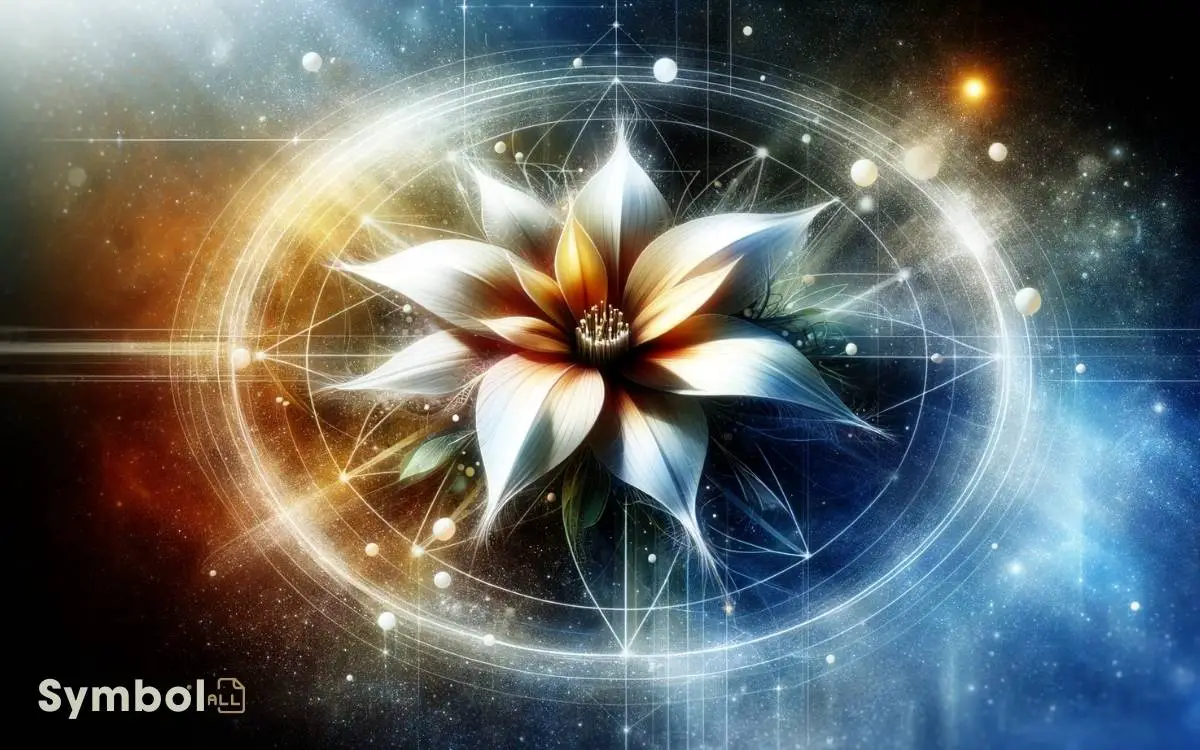Star of Bethlehem Flower Symbolism: Hope, Purity!
The Star of Bethlehem flower symbolizes hope, purity, and new beginnings. Its white petals represent innocence and clarity, deeply tied to Christian scripture as a guiding light.
Scientifically, it contains cardiac glycosides, used in traditional medicine for its anti-inflammatory properties.
Culturally, it signifies forgiveness and reconciliation, embodying societal harmony. Its blooming in spring underscores themes of rebirth and resilience.
This flower, thriving under various conditions, becomes a beacon of aspiration. Its enduring value is evident in both ornamental and therapeutic uses, reflecting human reliance on nature’s bounty for guidance and healing.
Exploring further reveals its rich tapestry of symbolism across cultures and ages.

Key Takeaways
Historical Significance
The historical significance of the Star of Bethlehem flower traces back to ancient civilizations, where it was revered for its perceived mystical properties and medicinal uses.
You’ll find that these civilizations often integrated the flower into their daily lives, not just for its aesthetic appeal but for its purported healing abilities.
Scientific analysis reveals that the plant contains compounds such as cardiac glycosides, which have been used in traditional medicine to treat heart conditions.
In addition, its bulb has been applied in poultices to reduce inflammation and alleviate pain. This dual utility, both ornamental and therapeutic, underscores the flower’s enduring value.
Its cultivation and use over millennia highlight a deep-seated human penchant for harnessing nature’s bounty for health and beauty, a practice as relevant today as it was in antiquity.
Biblical Connections
In exploring the Star of Bethlehem flower‘s biblical connections, one uncovers its symbolic representation tied closely to narratives found in Christian scripture.
This flower, scientifically known as Ornithogalum, holds a significant place in Christian symbolism due to its name and appearance, which are reminiscent of the celestial phenomenon guiding the Magi to Jesus Christ’s birthplace in the Gospel of Matthew.
The linkage isn’t merely superficial; it explores the ideals of guidance, hope, and revelation that the biblical star symbolized.
Analyzing the texts, one finds that the flower’s connection to these themes isn’t accidental but a deliberate reflection of its role as a symbol in Christian iconography, embodying the light and guidance provided by the star on that significant night.
Symbol of Purity
You’ll find that the Star of Bethlehem flower embodies purity in its most unadulterated form. Its pristine white petals serve as a symbol of innocence, untouched by the complexities of the world.
This botanical marvel captures the essence of purity through both its appearance and the symbolism it carries across cultures.
Pure Essence Captured
Delving into the Star of Bethlehem’s symbolism, we uncover that its radiant white petals epitomize purity, reflecting an almost ethereal essence rarely captured in other floral representations.
This purity is not just a aesthetic attribute but a deep, symbolic message woven into the fabric of its existence.
| Aspect | Detail |
|---|---|
| Color | White |
| Symbolism | Purity |
| Floral Essence | Ethereal |
| Comparison | Unique among flowers |
| Cultural Perception | Symbol of clarity and innocence |
Analyzing the Star of Bethlehem, its pure white color isn’t coincidental but a deliberate representation of innocence and clarity.
Unlike many flowers that evolve vibrant hues to attract pollinators, the Star of Bethlehem’s choice of white speaks to a strategy of appealing to those seeking purity in form and substance.
Innocence Embodied
The Star of Bethlehem flower embodies innocence through its pure white petals, representing a pristine symbol of purity in the domain of flora.
This plant, scientifically known as Ornithogalum umbellatum, showcases characteristics that pinpoint its representation of innocence:
- Floral Morphology: The radiating petals form a perfect star, symbolizing untouched and untainted purity.
- Color Significance: White, universally acknowledged for purity and innocence, dominates its appearance.
- Growth Habit: It emerges in spring, a season often associated with new beginnings and the rebirth of nature.
- Cultural Interpretations: Historically, its presence in art and literature has reinforced its symbolism of new life and purity.
Understanding this flower’s symbolism requires analysis of both its biological attributes and its cultural significance, highlighting its role as a natural emblem of innocence.
Emblem of Hope
In analyzing the Star of Bethlehem flower‘s symbolism, it’s evident that this bloom serves as a potent emblem of hope, embodying resilience and the promise of renewal.
Scientifically known as Ornithogalum, the plant’s robust growth cycle, from bulb to bloom, mirrors the journey from darkness into light. This parallels human experiences of overcoming adversity, underscoring its significance as a symbol of hope.
Its stark white petals radiate outwards, resembling a star, which in many cultures is a universal sign of guidance and aspiration.
The flower’s ability to thrive in various conditions, often blooming with vigor after winter’s harshness, further accentuates its role as a beacon of hope, inspiring individuals to persevere through challenges with the assurance of brighter days ahead.
Representation of Forgiveness
You’ll find the Star of Bethlehem‘s symbolism deeply rooted in historical narratives of forgiveness, often serving as a visual metaphor for absolution and reconciliation.
Analyzing its role in personal healing, the flower’s presence signifies a profound impact on mending strained relationships and fostering understanding.
Within contemporary culture, its significance continues to resonate, underscoring its timeless appeal across various societies as a beacon of forgiveness.
Historical Forgiveness Symbolism
Throughout history, many cultures have embraced the Star of Bethlehem flower as a potent symbol of forgiveness, attributing to it various meanings tied to the act of pardoning transgressions.
This connection likely stems from the flower’s unique characteristics and the stories surrounding its origin.
In analyzing the symbolism, consider the following:
- The flower’s radiant appearance symbolizes purity and a new beginning.
- Its resilience in various climates represents the inclusive nature of forgiveness.
- The bloom’s seasonal return mirrors the cyclical opportunity for reconciliation.
- The widespread growth signifies the universal value of forgiveness across cultures.
These aspects contribute to a thorough understanding of the Star of Bethlehem’s role in historical forgiveness symbolism. It encapsulates the intricate interplay between human emotions and the natural world, reaffirming the significance of forgiveness in societal harmony.
Personal Reconciliation Impact
Embodying the essence of forgiveness, the Star of Bethlehem flower serves as a profound symbol for personal reconciliation, illustrating how this act can profoundly transform individual relationships and self-perception.
Scientific analysis reveals that the process of forgiving, symbolized by this flower, activates neural pathways associated with emotional regulation and stress reduction.
This biological response not only alleviates psychological burdens but also fosters a healthier interpersonal dynamic.
Cultural Significance Today
Building on its role in personal reconciliation, the Star of Bethlehem flower’s symbolism has permeated cultural contexts, representing forgiveness in contemporary society.
This shift from an individual to a societal symbol is underscored by its ubiquitous presence in various cultural manifestations.
Specifically, its significance is emphasized through:
- Artistic representations: Utilized in art to symbolize peace and the resolution of conflict.
- Literary references: Frequently mentioned in literature as a metaphor for forgiveness and new beginnings.
- Ceremonial uses: Incorporated into ceremonies that mark reconciliation and forgiveness.
- Public spaces: Planted in gardens dedicated to remembrance and reconciliation.
These instances underscore the flower’s role as a potent symbol for forgiveness, bridging personal healing with broader societal reconciliation. Its presence serves as a reminder of the transformative power of forgiveness in mending interpersonal and communal divides.
Connection to New Beginnings
The Star of Bethlehem flower symbolizes new beginnings due to its role in heralding significant life events and changes.
Its botanical characteristics and life cycle lend themselves to this interpretation, as it emerges in the spring, a season often associated with renewal and growth.
| Aspect | Significance |
|---|---|
| Blooming Season | Spring, a natural time for new beginnings |
| Botanical Name | Ornithogalum umbellatum, suggesting uniqueness |
| Growth Pattern | Rapid emergence, symbolizing swift changes |
| Cultural Use | Used in celebrations marking new phases in life |
These attributes underscore the flower’s connection to the theme of new beginnings, resonating deeply with those seeking symbols of hope and renewal.
Its presence in various cultural practices further emphasizes its universal appeal as an emblem of starting anew.
Themes of Rebirth
Delving into themes of rebirth, it’s notable how the Star of Bethlehem flower represents a profound cycle of regeneration and renewal, mirroring ecological and biological processes.
This emblem of resurrection isn’t merely symbolic but is rooted in the plant’s lifecycle and interaction with its environment.
To underscore its significance:
- Perennial Growth: It re-emerges yearly, embodying persistence and the continuity of life.
- Adaptive Resilience: Its ability to thrive in various conditions illustrates nature’s adaptability.
- Seasonal Blooming: The flower’s blooming cycle signifies the perpetual renewal inherent in natural ecosystems.
- Pollination Process: Acts as a catalyst for the regeneration of life, ensuring biodiversity and ecological balance.
Understanding these aspects, you grasp how the Star of Bethlehem encapsulates the essence of rebirth, reflecting broader ecological truths.
Inspirations in Art
Reflecting on the Star of Bethlehem‘s significance in rebirth, it’s remarkable how this motif has inspired myriad interpretations and depictions in the domain of art, embodying themes of hope, renewal, and the cycle of life.
Artists have meticulously utilized the flower’s intricate structure and luminosity as a symbolic tool, integrating it into various mediums.
Through detailed brushstrokes and precise color palettes, painters have captured the flower’s essence, often juxtaposing its delicate appearance against backgrounds that evoke deeper, sometimes darker themes.
This contrast highlights the flower’s role as a beacon of light and hope amidst adversity.
Sculptors, too, have abstracted the flower’s form to explore its symbolic potential further, creating works that invite viewers to contemplate themes of birth, death, and rebirth from fresh perspectives.
Influence in Literature
You’ll find that the Star of Bethlehem flower holds a notable place in literature, with its symbolic meanings woven intricately into narratives and themes.
This section examines the breadth of literary references to the flower, analyzing how authors have historically leveraged its symbolism to enrich their works.
Through a detailed exploration, you’ll understand the nuanced roles this emblematic bloom has played, from evoking themes of hope and renewal to symbolizing ephemeral beauty.
Literary References Overview
The Star of Bethlehem flower has greatly influenced various literary works, symbolizing themes of hope, purity, and new beginnings. This emblematic bloom has been woven into narratives and poetry, serving as a powerful metaphor for transformation and the divine.
- Narrative Symbolism: Authors often use the Star of Bethlehem to signify pivotal moments of change or enlightenment in their characters’ journeys.
- Poetic Metaphor: Poets liken the flower to a guiding light, much like its biblical namesake, to evoke deep emotional responses.
- Thematic Presence: Its inclusion in literature typically heralds themes of redemption, innocence, or miraculous revelations.
- Character Development: The flower’s symbolism can mirror or foreshadow the evolution of a character, underscoring their growth or purification.
These literary references underscore the flower’s enduring symbolic potency and its capacity to convey complex themes through a single, natural image.
Symbolic Meanings Explored
In exploring the influence of the Star of Bethlehem flower in literature, it’s important to analyze how authors and poets have intricately woven its symbolic meanings into the fabric of their narratives and verse.
This emblem of purity, hope, and rebirth often serves as a metaphor for transformation and the power of renewal within the human spirit.
Literary analysis reveals a nuanced application, where the flower’s appearance not only heralds change but also underscores moments of profound realization or enlightenment.
Its presence can subtly shift a narrative’s tone, imbuing scenes with a sense of awe or divine intervention, thereby enriching the text’s layers of meaning.
Through careful examination, one uncovers the flower’s role in symbolizing both literal and figurative new beginnings, offering insights into the complexity of human emotions and experiences.
Use in Ceremonies
Often, people incorporate the Star of Bethlehem flower into various ceremonies due to its symbolic significance and aesthetic appeal. This practice isn’t arbitrary but deeply rooted in the flower’s attributes, which offer a multifaceted symbol in ceremonial contexts.
Its pure white petals represent purity and innocence, making it a popular choice for weddings and baptisms.
Key reasons for its ceremonial use include:
- Symbolic purity: Ideal for events marking new beginnings or spiritual milestones.
- Visual appeal: Adds elegance and simplicity to decorations.
- Versatility: Complements various floral arrangements and themes.
- Cultural resonance: Holds significance in many traditions, enriching the ceremony’s meaning.
Understanding these factors helps you appreciate the Star of Bethlehem’s role beyond its aesthetic value, recognizing its capacity to convey deep symbolic meanings within ceremonial settings.
Varieties and Meanings
Several varieties of the Star of Bethlehem flower exist, each carrying its own unique symbolism and significance within different cultural contexts.
You’ll find that the diversity of these flowers extends beyond their aesthetic appeal, embedding deeper meanings and associations.
To provide a clearer understanding, here’s a concise table outlining some notable varieties and their meanings:
| Variety | Color | Symbolism |
|---|---|---|
| Ornithogalum umbellatum | White | Purity, Hope |
| Ornithogalum dubium | Orange | Enthusiasm, Vibrancy |
| Ornithogalum nutans | White, Green | Peace, Reconciliation |
| Ornithogalum saundersiae | White, Black | Strength, Survival |
| Ornithogalum thyrsoides | White | Innocence, Sympathy |
These varieties illustrate the flower’s adaptability and the breadth of its meanings across different species. Each color and type resonates with specific emotions and messages, making the Star of Bethlehem a versatile symbol in various cultural narratives.
Cultivation and Care
Cultivating the Star of Bethlehem flower requires understanding its specific needs for sunlight, soil, and water to guarantee healthy growth and blooming. This species thrives under certain conditions that mimic its natural habitat.
- Sunlight: Prefers full sun to partial shade, requiring at least 6 hours of direct sunlight daily.
- Soil: Well-drained, fertile soil with a neutral to slightly acidic pH is ideal.
- Watering: Consistent moisture is essential, especially during the growing season, but avoid waterlogging.
- Temperature: Tolerates a wide range but flourishes in temperate climates.
Implementing these guidelines ensures the optimal development of the Star of Bethlehem, allowing it to exhibit its full ornamental potential. Understanding these cultivation parameters is pivotal for anyone aspiring to grow this symbolically rich plant effectively.
Conclusion
In wrapping up, it’s essential to mention that the Star of Bethlehem flower, beyond its profound symbolism, is cultivated worldwide, with over 50 species known.
Surprisingly, despite its widespread cultivation, a specific variety, Ornithogalum umbellatum, dominates in popularity, accounting for approximately 60% of all cultivated species.
This statistic underscores the flower’s versatility and enduring appeal, reflecting its symbolic significance across cultures.
Careful cultivation practices guarantee its continued presence, embodying purity, hope, and forgiveness in diverse settings.






